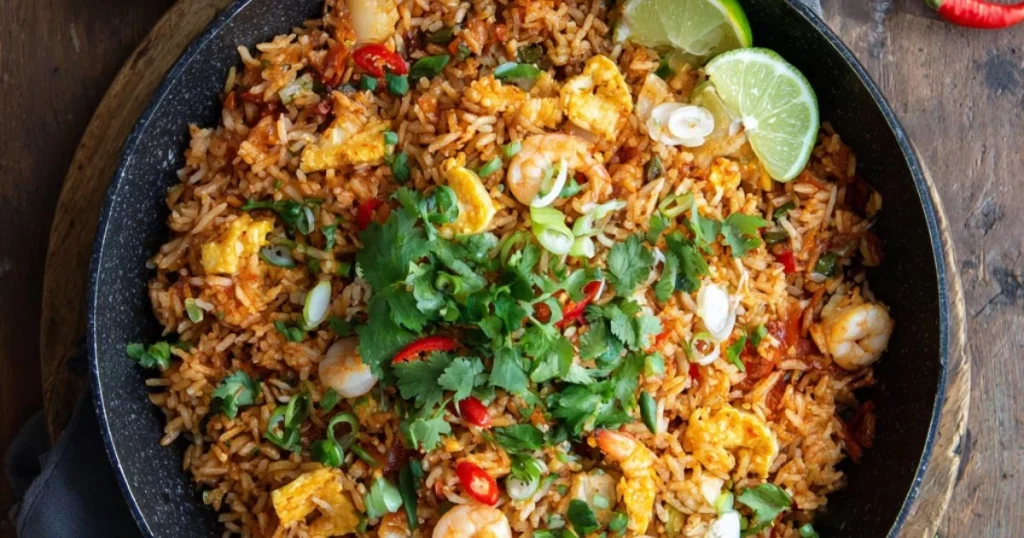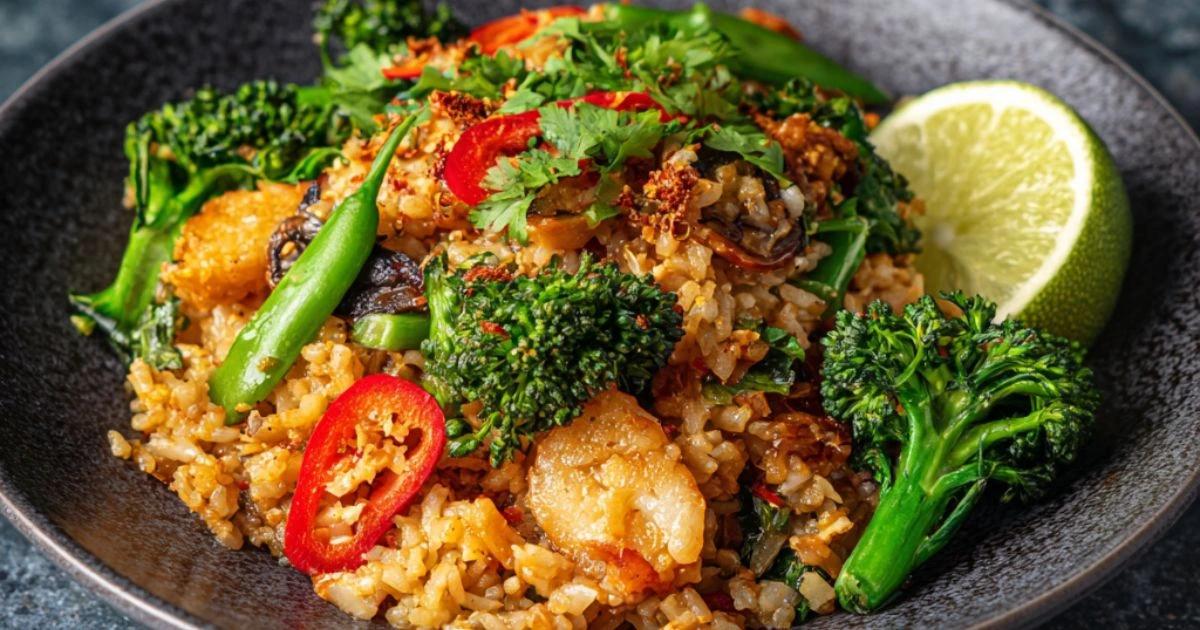Vegan Tom Yum Fried Rice
Thai cuisine is famous for its bold harmony of spicy, sour, salty, and sweet. Among the many iconic dishes, tom yum stands out as the perfect balance of those flavours — and when turned into a fried rice version, it becomes a quick, flavour-packed meal that satisfies both vegan and foodie appetites alike.
Whether you’re a plant-based eater seeking a taste of Thailand or simply looking for a creative way to transform leftover rice, vegan tom yum fried rice delivers that irresistible umami depth with vibrant herbs, zesty lime, and a gentle heat that wakes up your palate.
For inspiration and authentic preparation methods, check out Viet Vegan’s vegan tom yum fried rice recipe and Authentic Thai Recipes’ tom yum fried rice guide. Both sources highlight how easy it is to adapt the traditional Thai dish into a delicious plant-based fried rice bursting with tangy flavour.
What Is Tom Yum? Understanding the Origins and Flavour Profile
Tom yum (ต้มยำ) is a traditional Thai hot and sour soup known for its sharp, aromatic blend of lemongrass, kaffir lime leaves, galangal, chilli, and lime juice. Traditionally, tom yum includes seafood or shrimp paste — but for vegan tom yum fried rice, we keep all the citrusy, herbal elements while removing the animal ingredients.
What makes tom yum fried rice special is how it captures those soup flavours in a wok-fried form. The result is a dish that’s aromatic, slightly tangy, and deeply savoury without being heavy.
Veganizing this dish means replacing fish sauce or shrimp paste with soy sauce, tamari, or mushroom broth powder, so you keep that umami depth while maintaining a 100% plant-based profile.
Key Ingredients for Vegan Tom Yum Fried Rice
To create authentic-tasting vegan tom yum fried rice, the key lies in balancing flavour and texture. Here’s what you’ll need:
1. The Rice
- Use day-old jasmine rice — slightly dried out for the best texture.
- Avoid freshly cooked rice as it tends to get soggy when stir-fried.
- Long-grain rice or brown rice can also work, but adjust the frying time slightly.
2. Vegan Tom Yum Paste
- You can make your own or buy a store-bought vegan version.
- Homemade paste ingredients:
- Lemongrass
- Galangal
- Kaffir lime leaves
- Garlic and shallots
- Thai red chillies
- Tamarind paste for sourness
- Mushroom seasoning or soy sauce for umami
Making it yourself ensures it’s fully vegan-friendly, as some pre-made pastes contain fish sauce or shrimp extract. Learn how to build flavour from scratch in East Meets Kitchen’s video on vegan tom yum fried rice.
3. Vegetables & Protein
- Firm tofu, TVP, or tempeh for plant-based protein.
- Colorful vegetables like bell peppers, mushrooms, snap peas, and carrots.
- Optional: add pineapple chunks for a tropical twist.
4. Seasonings & Finishing Touches
- Soy sauce or tamari
- Palm sugar or brown sugar
- Lime juice for acidity
- Chopped cilantro, Thai basil, and green onions for garnish
- Optional toppings: roasted cashews, sesame seeds, or chilli flakes
Preparing for Success: Equipment & Tips
A few essential steps make all the difference in achieving perfect fried rice texture and authentic tom yum flavour.
- Use a wok or large frying pan to distribute heat evenly.
- Prepare all ingredients ahead of time — stir-frying is fast-paced.
- Cook on high heat to ensure the rice gets that classic “wok hei” (wok breath).
- Avoid overcrowding the pan — fry in small batches if needed.
- Check your paste for non-vegan ingredients; fish sauce and shrimp paste are common additives in Thai cooking.
Step-by-Step Instructions
Follow this method for the most flavourful vegan tom yum fried rice:
- Prepare the paste
- Blend lemongrass, galangal, garlic, chillies, kaffir lime leaves, tamarind, and soy sauce until smooth.
- Add a splash of water if needed to achieve a paste-like consistency.
- Cook the aromatics
- Heat oil in a wok on medium-high heat.
- Add shallots, garlic, and 1–2 tablespoons of your tom yum paste.
- Stir-fry for 1–2 minutes until fragrant.
- Add protein and vegetables
- Toss in diced tofu or tempeh, followed by your chosen vegetables.
- Stir-fry for another 3–4 minutes, allowing everything to soak up the paste’s flavour.
- Add the rice
- Break up the day-old rice to prevent clumps.
- Stir vigorously to coat each grain with paste and aromatics.
- Season and balance
- Add soy sauce, lime juice, and a pinch of sugar.
- Adjust to taste — more lime for sourness, more chilli for spice.
- Finish and serve
- Remove from heat, sprinkle fresh herbs, and serve hot.
- Garnish with lime wedges, roasted cashews, and chilli flakes.
Pro Tip: Keep your rice moving constantly in the wok to prevent burning and ensure each grain gets a smoky edge.

Vegan Substitutions and Adjustments
Traditional tom yum fried rice recipes often include fish sauce, shrimp paste, or egg, which are not vegan-friendly. Luckily, with a few simple swaps, you can easily create an authentic vegan tom yum fried rice that’s bursting with the same zesty, savoury flavour.
- Fish sauce substitute: Combine soy sauce, mushroom seasoning, and a squeeze of lime juice for that salty-umami hit. You can also try vegan fish sauce brands made from seaweed and mushrooms.
- Shrimp or meat replacement: Use crispy tofu, king oyster mushrooms, or tempeh to add texture and protein. Marinate them in a bit of tom yum paste before stir-frying for extra flavour.
- Egg replacement: Skip it or use scrambled silken tofu to mimic the richness of egg.
- Rice options: While jasmine rice is traditional, brown rice or cauliflower rice make great gluten-free or low-carb alternatives.
- Flavour boosters: Adjust sourness with tamarind paste or lime juice, add sweetness with palm sugar, and balance spice with coconut sugar or extra herbs.
These vegan substitutions ensure your tom yum fried rice stays bold, aromatic, and deeply satisfying—without compromising your plant-based lifestyle.gal, try frozen or dried versions — they’re available in most Asian grocery stores or online.
Serving Suggestions & Pairings
To elevate your vegan tom yum fried rice, consider:
- Garnishing with fresh lime wedges, cilantro, and Thai basil.
- Pairing with sides like:
- Vegan Thai spring rolls
- Papaya salad (som tum)
- Coconut soup (tom kha gai, made vegan with coconut milk and mushrooms)
- For drinks, pair with iced lemongrass tea or Thai iced coffee for a perfect contrast of hot and cold.
It’s also excellent for meal prep: portion it into containers and reheat it for lunch or dinner throughout the week.
Tips for Success & Common Mistakes
Keep these key points in mind for the best results:
- Use cold, day-old rice — fresh rice will clump and turn mushy.
- Cook in batches to maintain heat in your wok.
- Adjust the seasoning gradually — lime juice and soy sauce should complement, not overpower.
- Don’t overcook vegetables; they should remain crisp and colourful.
- Avoid using too much paste — it’s concentrated and can overpower the dish.
- Check labels when buying tom yum paste to ensure it’s vegan.
- Crisp the tofu beforehand to add a chewy, meaty texture.
Why Vegans and Foodies Love This Dish
What makes vegan tom yum fried rice so beloved is its perfect fusion of Thai complexity with the simplicity of stir-fry cooking.
- It’s nutrient-rich with vegetables and plant proteins.
- The flavours are bold yet balanced — spicy, sour, and aromatic.
- It’s a sustainable meal, ideal for using leftover rice and vegetables.
- Every bite brings authentic Thai flair without any animal-based ingredients.
This is the kind of dish that makes plant-based eating feel exciting, not restrictive.
Nutritional Benefits
Beyond taste, this dish is incredibly nourishing:
- High in plant protein from tofu or tempeh.
- Packed with vitamins from fresh herbs and vegetables.
- Low in saturated fat, yet filling and energizing.
- High fibre content when using brown rice or additional vegetables.
- Rich in antioxidants from ingredients like galangal, lime, and chillies.
To keep sodium in check, choose low-sodium soy sauce and taste as you cook.
FAQ: Vegan Tom Yum Fried Rice
Q1. Is tom yum paste vegan?
No, not always. Many contain fish sauce or shrimp paste. Choose a labelled vegan tom yum paste or make your own using mushroom stock and tamarind.
Q2. What rice works best?
Day-old jasmine rice is ideal for texture and aroma. Avoid sticky or freshly cooked rice.
Q3. Can it be gluten-free?
Yes — use tamari instead of soy sauce and ensure your paste is gluten-free.
Q4. How spicy is it?
It can range from mild to very spicy. Adjust the number of chillies and paste to your preference.
Q5. Can I use brown rice or quinoa?
Absolutely! Brown rice adds a nutty flavour, while quinoa offers a light, protein-rich twist.
Q6. How long do leftovers last?
Store in the fridge for 1–2 days in an airtight container. Reheat on high heat in a wok to refresh the texture.
Conclusion
Vegan tom yum fried rice is a true celebration of Thai flavours made accessible to everyone — spicy, aromatic, and bursting with zest. It’s proof that vegan cooking doesn’t mean sacrificing authenticity or depth.
So, grab that leftover rice, whip up some vegan tom yum paste, and get your wok sizzling. Whether you’re new to vegan Thai cuisine or a seasoned cook, this dish is sure to become a weeknight favourite.
Try it tonight — your kitchen will smell like Bangkok, and your taste buds will thank you.







